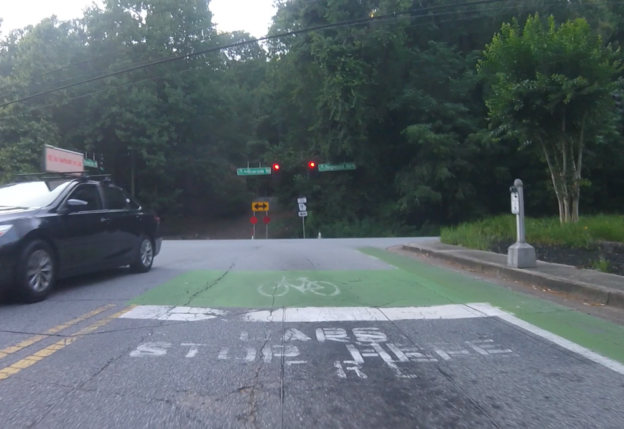This is a surprisingly common question from drivers any time the discussion of bicycles on the roads comes up. Unfortunately, while the law is fairly clear on this, it seems to confuse a lot of drivers (and cyclists too). So, let us delve into this in detail and evaluate just what the law means and intends. There are several parts to this discussion, and a couple of different laws that come into play here, so we will need to deal with a few different situations to illustrate the issues.
There are really 3 scenarios that exist and raise this question.
Road with a Bike Lane
When there is a bike lane, there should be no doubt here. If a bike is using a bike lane, it is no different than a car in a seperate lane. It should move as far forward as the traffic in that lane allows.
That said, just because there is a bike lane present, a cyclist is NOT required to use it.
Road with a Shoulder
This is where the confusion begins. If there is not a bike lane, does that change things? Well, looking to the law we get a clear answer from 40-6-291.
40-6-291
(b) Notwithstanding the provisions of Code Section 40-6-50, any person operating a bicycle may ride upon a paved shoulder; provided, however, that such person shall not be required to ride upon a paved shoulder.
Meaning that where there is a shoulder a bicycle may use it, but they may not be required to use it in the same way as they are given the option regarding the use of a bike lane when it is present. Given that, yes, they absolutely can pass on the right using a shoulder as if it is a bike lane.
Road without a Shoulder
This case is the one where things become a little less clear. Part of the confusion stems, oddly enough, from the very same 3′ law designed to protect cyclists on the roads. For the purpose of this discussion we are going to use the version of the the 3′ law that becomes effective July 1st.
40-6-56. Safe distance defined; application to bicyclist.
(a) The operator of a motor vehicle approaching a bicycle shall approach the bicycle with due caution and shall proceed as follows:
(1) Make a lane change into a lane not adjacent to the bicycle if possible in the existing road and traffic conditions; or
(2) If a lane change under paragraph (1) of this subsection would be impossible, prohibited by law, or unsafe, reduce the speed of the motor vehicle to a reasonable and proper speed for the existing road and traffic conditions, which speed shall be at least ten miles per hour less than the posted speed limit or 25 miles per hour, whichever is more, and proceed around the bicycle with at least three feet between such vehicle and the bicycle at all times.
(b) Any violation of this Code section shall be a misdemeanor punished by a fine of not more than $250.00.
When people hear and relate to the 3′ law, the common perception is that it applies to cyclists as well, and that a bicycle must also give a car ot truck that same 3′. The wording of the law however is quite clear. The explicit use of the “motor vehicle” designation as well as specifically addressing as a motor vehicle passing a bicycle and never in the reverse context.
So, no a bike does not have to give a car 3′ feet, and as there is an expectation of shared space, there is no prohibiton from a bike passing a car in the shared lane, any more than there is for a car to pass a bike, given that it can be done safely, and without leaving the roadway or paved portion of the shoulder, something that is a common occurence with cars going around left turning cars, which is, I might add, also illegal.
Things a Bike Cannot Do
All of that said, there are things that a bicycle cannot do to pass traffic at a stop control.
- A cyclist cannot leave the road and ride down the grass/dirt area next to the roadway.
- A cyclist (over the age of 12) cannot use a parallel sidewalk ( unless it is a designated multi-use path ).
- A cyclist may not hold onto a vehicle in the roadway for stability or to be pulled along.
- A cyclist may not create an impact with a vehicle ( ‘flip the mirror’ ) in order to get past.
- A cyclist may not use a right hand turn lane to filter forward.
- A cyclist may not use a right hand turn lane to give space to allow cars to pass.
Things a Car Cannot Do
There are a couple of common behaviors that are also not legal to be aware of.
- A driver cannot move over to block a bike lane to prevent filtering.
- A driver cannot move over to block a shoulder to prevent filtering.
- A driver cannot allow a passenger to ‘door’ a filtering cyclist.
- A driver cannot throw things out the window at a filtering cyclist.
Conclusion
The reality is, there are few situations where a cyclist cannot legally filter forward, and in truth, statistically speaking filtering forward is the safest and least disruptive model for cyclists to follow. However, there are caveats to this. Groups generally should not filter. Many cyclists will elect not to filter when they know that the far side of an intersection presents a pinch point that places them at an elevated risk for a crash.
